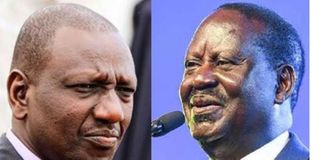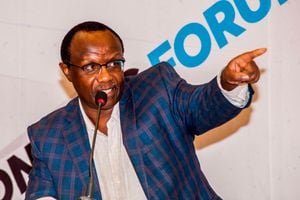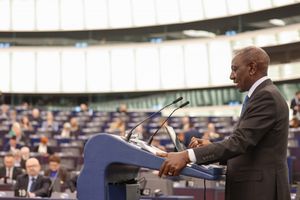What Raila Odinga wants, what President William Ruto needs

President William Ruto (left) and Azimio leader Raila Odinga.
President William Ruto and Azimio la Umoja One Kenya Coalition leader Raila Odinga – adversaries with a love-hate relationship spanning three decades – are once again locked up in a gladiatorial contest that could define the country’s political landscape in years to come.
At least 10 people died in the anti-government protests on Wednesday, bringing the total to 23, according to the United Nations Human Rights Office, which has called for a “prompt, thorough, independent and transparent investigations into the deaths and injuries”.
“The UN Human Rights Office is very concerned by the widespread violence, and allegations of unnecessary or disproportionate use of force, including the use of firearms, by police during protests in Kenya. Reports say up to 23 people have been killed and dozens injured in the demonstrations in the past week,” the office spokesperson Jeremy Laurence said in a statement.
But for political analysts, international observers, and the ordinary Kenyan, the question on everyone’s mind is what the endgame is for the two leaders, and how they navigate this latest political battle.
With plans for intensified three-days-a-week opposition protests and a tough stand taken by the Kenya Kwanza alliance administration, analysts think the standoff can only be solved politically and not suppressed by force.
Some talk of some form of “handshake” (the March 9, 2018 truce between then-President Uhuru Kenyatta and Mr Odinga) or “nusu mkate” (the grand coalition of then-President Mwai Kibaki and Mr Odinga after the disputed 2007 election) government is Mr Odinga’s ultimate goal.
There are constitutional hurdles in achieving some of those proposed but some form of “cooperation” or “working together” like happened with President Kenyatta without necessarily joining government is seen as a possibility.
The veteran opposition leader says that is not his objective while President Ruto and his deputy Rigathi Gachagua have repeatedly used the “handshake” narrative – unpopular in their strongholds – to attack Mr Odinga and his Azimio camp.
Indeed, even before the protests started early in the year, Dr Ruto, Mr Gachagua and other Kenya Kwanza leaders said they would not be blackmailed into allowing a “handshake” similar to the 2018 agreement Mr Odinga had with Mr Kenyatta.
So, how does Mr Odinga convince all that some “handshake” is not his ultimate goal and how does the President push the counter argument?
“Odinga does not go for handshakes. He is approached for a handshake,” Turkana University don, Tom Nyamache, told the Sunday Nation.
“In the current situation, sobriety should reign and the government should listen to genuine cries on the high cost of living.”
Prof Nyamache advised the opposition to “stop criticising the government without tangible solutions to the problems facing Kenyans”.
Governance expert, Javas Bigambo, says whichever way the duel goes, it will have a significant bearing on the careers of Dr Ruto and Mr Odinga.
“Whatever choices are made, the country has to bear the consequences,” Mr Bigambo said.
According to Mr Bigambo, Mr Odinga has upped the agitation against the President because he (Odinga) “doesn’t want to be subdued after being defeated in the last election”.
“The agitation is circumstantial, aided by the cost of living and proposed tax regime, all of which he is milking to his advantage,” he said.
Religious leaders have called for a truce, with the National Council of Churches of Kenya (NCCK), the Kenya Conference of Catholic Bishops (KCCB) and the Supreme Council of Kenya Muslims telling President Ruto to “reverse Kenya’s downward spiral into the abyss”.
“We urge that you open the way for dialogue and consultations as a way of addressing the longstanding and deep-seated grievances in the country so as to promote healing and reconciliation,” the religious leaders said in a statement signed by NCCK head Timothy Ndambuki, his KCCB colleague Martin Kivuva and Supkem chairman Hassan ole Naado.
The clergy told Mr Odinga to change tact on the mass action “which is pushing the country into insurrection”.
“We urge you to embrace dialogue and consultations as a strategy for addressing grievances. Collecting signatures so as to overthrow the government is dangerous and should be withdrawn,” the statement added.
Mr Odinga’s “politics of grievance” over elections has been used to label him an eternal whiner.
The 2022 elections have not been different after he failed to overturn the results at the Supreme Court.
The opposition leader’s original demand in the calls for “maandamano” (protests) was that the servers used by the Independent Electoral and Boundaries Commission (IEBC) be opened to audit results of the August 9, 2022 poll and enable reclaiming of his supposedly stolen victory.
A closely linked demand has been that the process of recruiting IEBC commissioners be inclusive.
IEBC was a key agenda in the botched talks, which were to be spearheaded by a 14-member team co-chaired by MPs George Murugara (Tharaka, United Democratic Alliance – UDA) and Dr Otiende Amollo (Rarieda, Orange Democratic Movement – ODM).
Dr Amollo and Azimio pulled the plug on the talks, citing lack of goodwill by the Kenya Kwanza, with the Dr Ruto team last month demanding the resumption of the IEBC commissioners’ recruitment if the opposition does not come back to the table.
“President Ruto should also the reconstitution of the IEBC until a proper method is reached. Though he has signed the Finance Bill, 2023 into law, President Ruto should kickstart a process to repeal it and stop burdening Kenyans. These are some of the things fuelling the protests,” said a two-term pro-Odinga MP from Western Kenya.
For Mr Odinga, cleaning up the electoral commission and having a say in recruitment is a crucial game plan for the next elections.
Dr Ruto must also, by political necessity, have a hand in the recruitment while at the same time not giving indication to support the perception among critics that he benefited from the previous commission and is keen to have a new compliant team.
The President, therefore, needs to be in the loop while at the same time act like a dispassionate outsider.
The Finance Act, 2023 – particularly contentious issues like the increase in Value Added Tax on fuel and the housing tax – has created discontent in Kenyans.
Mr Odinga and Azimio la Umoja One Kenya are using the cost of living and the new taxes as a stick to hit the government.
Including the cost of living as a demand in the protests is aimed at broadening Mr Odinga’s support and convincing those who view him as a perpetual troublemaker that he is fighting for their rights.
Mr Odinga’s camp now says the Finance Act should be repealed. Success on this front can only enhance his pro-people image.
In the meantime, the Kenya Kwanza government remains on tenterhooks, given a court case that has hated implementation of the Finance Act.
Dr Ruto’s political messaging of looking after the needs of the “hustler” has also in recent months come under scrutiny. It is increasingly being adopted by Mr Odinga, who was labelled part of the dominant “dynasty” in the last election.
ODM Secretary-General, Edwin Sifuna, said for Mr Odinga, the case against Dr Ruto is simple: Address the cost of living and the protests will cease.
“The protests are not a showdown between Raila and Ruto. It is about the people of Kenya and Ruto. All the people want is for Ruto to listen to them and address the high cost of living,” Mr Sifuna said.
“Raila says he can afford unga and fuel at whatever price. It is the people feeling the pain and not Raila. Once the people’s pain is addressed, the matter will end.”
Dr Ruto, analysts say, needs to manage the narrative that he is burdening ordinary Kenyans with taxes – something that has earned him choice nicknames.
His explanation has always been that the Kenyatta administration mismanaged the economy and Kenya Kwanza needs the taxes to clean up the mess and stop digging a deeper hole by borrowing.
He has also used the Us-versus-Them card in issues like the housing tax by repeatedly saying he is targeting those with pay slips and not Kenyans at the bottom of the pile.
The increase in VAT on fuel has, however, punctured this strand of argument since the prices of most goods and transport services have shot up exponentially as a consequence.
The worry is that the discontent is being felt even in Dr Ruto’s strongholds and he needs to reactivate the grassroots messaging that he has the interest of Kenyans, especially “hustlers”, at heart.
How he does this convincingly as ordinary people continue to feel the pinch remains a challenge
On cost of living, the religious leaders asked President Ruto to repeal the Finance Act, saying it is overburdening Kenyans already too stretched by taxes.
“We once again appeal that your administration repeals the Finance Act, 2023 so as to review the heavy burden it imposes on Kenyans. Maintaining the prevailing tax levels will give citizens a chance to recover their livelihoods and inspire hope,” the NCCK, KCCB and Supkem joint statement issued on Friday said.
Closely related to the bid to maintain his stronghold is that of Dr Ruto’s effort to get legitimacy and maintain an image of a president in charge.
To outsiders, Dr Ruto wants to project an international image of a new breed of African leaders who boldly address complex issues like dollarisation, climate change and the global financial system.
However, the President’s legitimacy is being challenged – with the signature collection and the protests that are increasingly becoming messy.
How his administration reacts to the protests is under the microscope, with the police particularly being heavily criticised. He has been cultivating the image of a Pan-Africanist interested in resolving issues around the continent and asserting Africa’s geopolitical position. This, it must be noted, straddles the country’s image and his personal stature.
Prof Masibo Lumala, a senior lecturer at Moi University in Eldoret, says for Dr Ruto, the threat of anarchy is real.
“The opposition and the government should be honest with each other. Losing lives is sad. President Ruto should call the opposition to the table and revive talks to end this madness,” Prof Lumala said.
“The government should also face the reality and, for instance, seek ways to lower the cost of living and provide solutions to unemployment, especially among the youth, as a long term solution. Instead of burdening Kenyans with heavy taxes, let the government expand the tax band; increase the number of Kenyans paying taxes.”
But with the world watching, what does President Ruto need to do?
The UN human rights body, among others, has made strong statements on the protests that could sully the well-cultivated image.
How does Dr Ruto navigate projecting the image of the ultimate African statesman leading a thriving democracy while at the same time continuing with the hardline stance that includes claims of excessive use of force?
Mr Odinga and President Ruto want to maintain their strongholds while at the same time gain enough political momentum to push them to the 2027 elections.
Whether he is a kingmaker or candidate, the veteran opposition leader will want to ensure he protects his strongholds from being chipped away by an aggressive adversary.
Dr Ruto also needs to keep his base happy and assure them he is working to deliver his promises without hurting their pockets.
According to Mr Bigambo, the end-game is to have a dual political architecture where Mr Odinga is elevated to peer reverence through a workable political compromise.
“That is Odinga’s political sociology. But President Ruto’s people know that if that happens, Raila Odinga will claim his wisdom in bringing the nation to order and working governance formula, and not all Kenya Kwanza policy frameworks in the Manifesto will be implemented,” Mr Bigambo said.
“President Ruto has to vanquish Mr Odinga and politically eliminate the fiercest competition, or condone him and face annihilation in 2027 through his antics. Either way, heavy choices have to be made.





